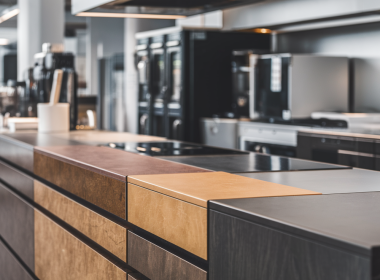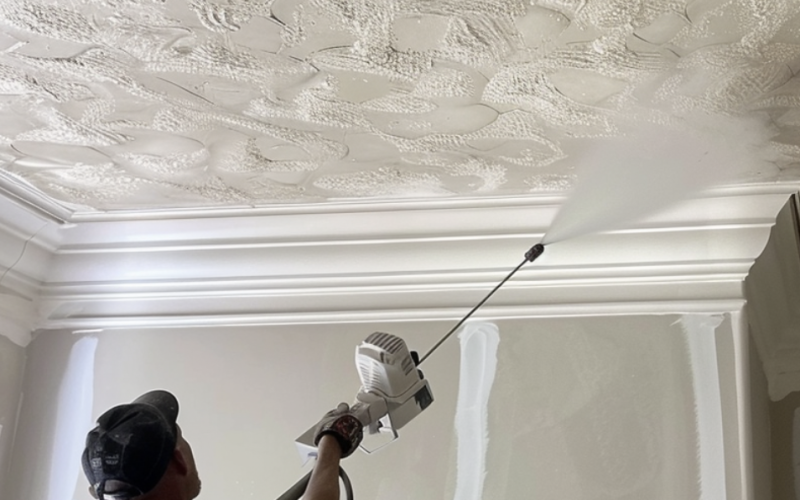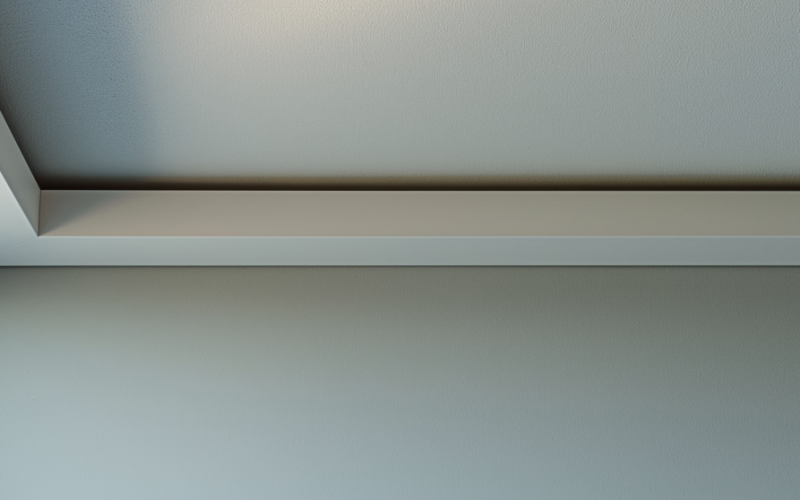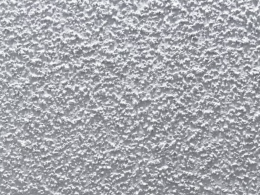Textured ceilings, including the popular “popcorn” style and other ceiling textures, can add character to a room but are notorious for trapping dust, dirt, and allergens.
This buildup not only looks unappealing but can also pose health risks, especially for those with allergies or respiratory issues.
Fortunately, with the right tools and techniques, cleaning your textured ceiling doesn’t have to be daunting.
In this article, we’ll explain the best methods for safely and effectively removing dirt, dust, and stains from your textured ceiling, leaving it fresh and clean.
We’ll cover the necessary precautions, essential tools, and step-by-step processes to help you achieve a spotless finish without damaging your ceiling’s delicate modern texture design.
Preparation Steps for Cleaning a Textured Ceiling
Start by assessing your ceiling for asbestos, especially if your home was built before 1990.
Textured ceilings installed before this time may contain asbestos, which can be hazardous if disturbed.
If you suspect your ceiling contains asbestos, contact a professional for testing and guidance on proceeding safely.
Once you’ve confirmed your ceiling is asbestos-free, gather essential safety gear.
Wear a dust mask to avoid inhaling particles, goggles to protect your eyes, and protective clothing to keep dust and debris off your skin and clothes.
Move as much furniture as possible out of the area to provide ample working space and prevent damage.
Cover any remaining furniture and the floor with tarps or plastic sheeting. This step will help contain falling dust and debris, making the cleanup process more manageable.
Cleaning Methods for Textured Ceilings
When cleaning your textured ceiling, there are two main methods to consider: dusting and stain removal.
Each approach requires techniques and tools to ensure effective cleaning without damaging the delicate texture.
1. Dusting
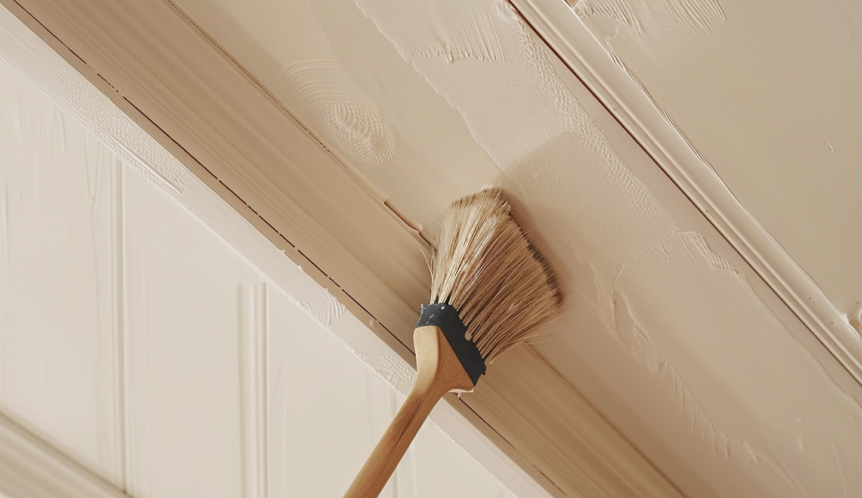
To dust your ceiling safely, use a vacuum cleaner with a soft brush attachment, gently running it over the surface.
Alternatively, you can use a soft feather duster or a lint roller to capture dust particles. Remember to handle the texture gently to avoid breakage or damage.
2. Stain Removal
Textured ceilings are prone to various types of stains, including those caused by grease, smoke, and environmental pollutants.
Identifying the type of stain is key to selecting the appropriate cleaning approach.
- Light stains: A solution of water and mild dish soap can be effective for lighter stains. Apply the mixture using a soft sponge or cloth, gently dabbing the stained area. Be sure to wring out excess water to avoid oversaturating the texture.
- Mold: If you have mold or mildew stains, a bleach solution may be necessary. Mix one bleach with three parts water and apply it to the affected area using a spray bottle or sponge. Allow the solution to sit for a few minutes before gently wiping it away with a damp cloth.
- Persistent stain: For persistent stains that don’t respond to these methods, consider using a stain-blocking primer followed by a fresh coat of paint. This approach will effectively cover the stain and refresh the appearance of your textured ceiling.
3. Deep Cleaning
When your textured ceiling requires a more thorough cleaning, combining methods may be necessary to achieve the best results.
Start by vacuuming the ceiling with a soft brush attachment to remove as much loose dust and debris as possible.
This step will make the subsequent cleaning process more effective and less messy.
After vacuuming, prepare a cleaning solution using warm water and a mild detergent or soap.
Dip a soft sponge or microfiber cloth into the solution, wringing out excess water to avoid oversaturating the texture.
Gently wipe the ceiling in sections, using light pressure to avoid damaging the texture. Rinse the sponge or cloth frequently in clean water to avoid redistributing dirt and grime.
Testing any cleaning solution on a small, inconspicuous area before applying it to the entire ceiling is crucial.
This precaution will help you ensure the solution won’t discolor, stain, or damage the texture.
Maintenance Tips for Textured Ceilings
- Aim to dust your ceiling at least once a month or more frequently if you live in a particularly dusty area or have pets that shed.
- As soon as you notice a stain, identify its type and apply the appropriate cleaning method, as discussed earlier in this article.
- Good air circulation helps keep the area dry, reducing the risk of mold and mildew growth, which can lead to staining and potential health hazards.
- Consider using fans, opening windows when weather permits, and running a dehumidifier in particularly damp areas, such as bathrooms or kitchens.
Considerations for Specific Ceiling Types
When cleaning textured ceilings, it’s important to consider the specific type of texture you’re dealing with, as different materials and application methods may require specialized care or precautions.
Popcorn Ceilings
Popcorn ceilings, acoustic or cottage cheese ceilings, are particularly delicate and require extra care when cleaning.
The soft, spongy texture can easily be damaged or dislodged if handled too roughly.
When cleaning a popcorn ceiling, always use the gentlest methods possible, such as light dusting with a feather duster or a vacuum cleaner with a soft brush attachment.
Do not attempt to clean or disturb the texture if you suspect asbestos. Instead, contact a professional asbestos abatement company to assess the situation and determine the safest course of action.
Other Textured Ceilings
Other textured ceilings, such as knockdown, swirl, or orange peel textures, may be more durable than popcorn ceilings, often made from harder materials like plaster or drywall compound.
While these textures still require gentle handling, they may withstand slightly more vigorous cleaning methods, such as using a soft-bristled brush or a slightly damp sponge.
However, it’s still essential to test any cleaning solution or method on a small, inconspicuous area before applying it to the entire ceiling to ensure it won’t cause damage or discoloration.
Conclusion
Cleaning your textured ceiling may seem daunting, but with the right tools, techniques, and precautions, you can effectively remove dirt, dust, and stains without damaging the delicate texture.
By following the preparation steps, choosing the appropriate cleaning method for your specific ceiling type, and maintaining a regular cleaning routine, you can keep your textured ceiling looking its best for years.
Remember, if you suspect your ceiling contains asbestos or have doubts about the best approach, don’t hesitate to consult a professional.
With a little time and effort, you can enjoy a clean, fresh-looking textured ceiling that enhances the beauty and comfort of your home.
So, grab your supplies, put on some music, and get ready to tackle that ceiling!



